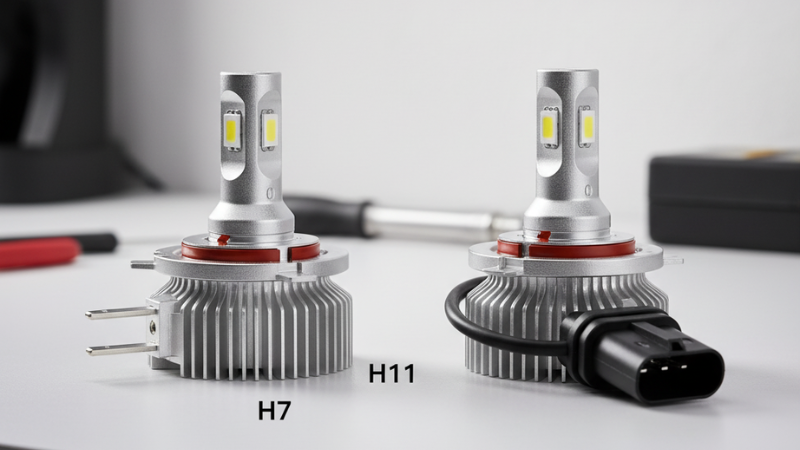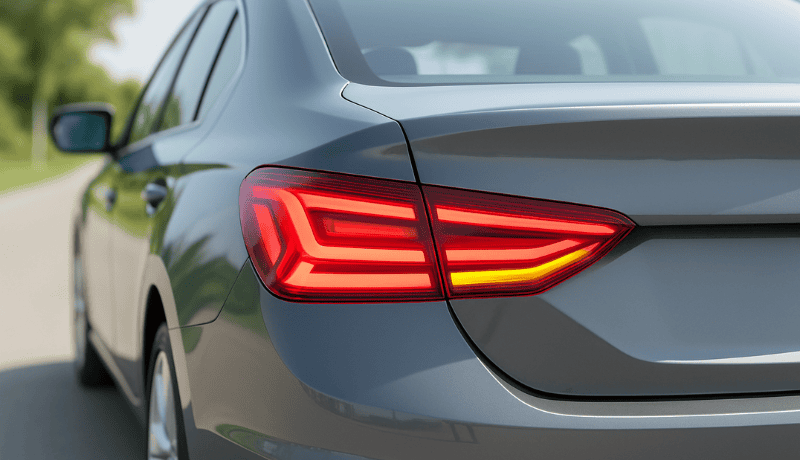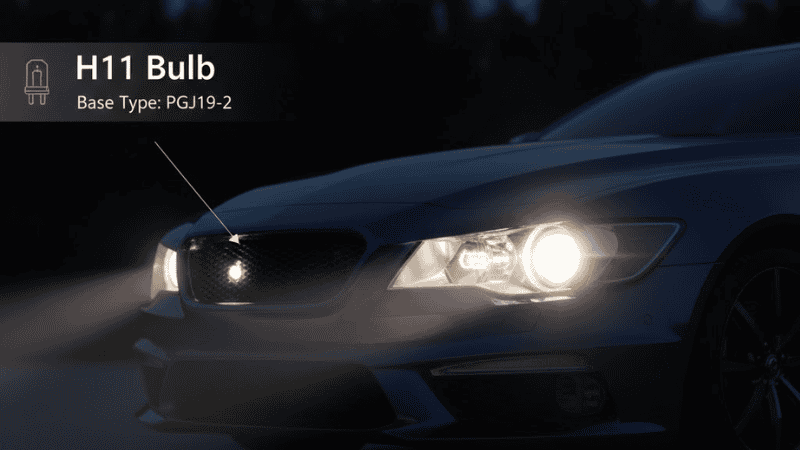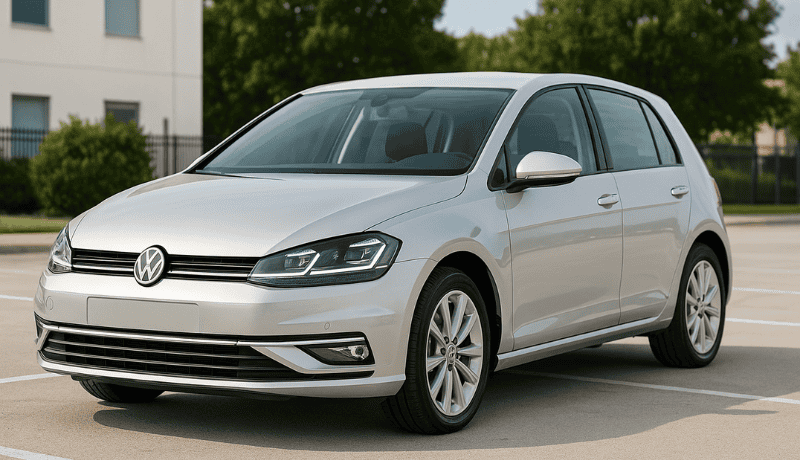In today’s automotive aftermarket, clarity on H7 vs H11 bulb specifications is crucial. These two bulbs are often grouped together, but their technical differences impact their functionality.
Misunderstanding an H7-led headlight bulb with an H11 can result in a dissatisfied customer. Hence, we have created this special guide that will help you gain a clearer idea of bulb specifications.
Basic Definitions and Technical Specs
Clarity begins with the basics, whether you are comparing bulb options for inventory or installation. Both H7 and H11 look similar; however, they differ vastly in application and design. This makes it impossible to interchange one for the other.
H7 LED Headlight Bulb
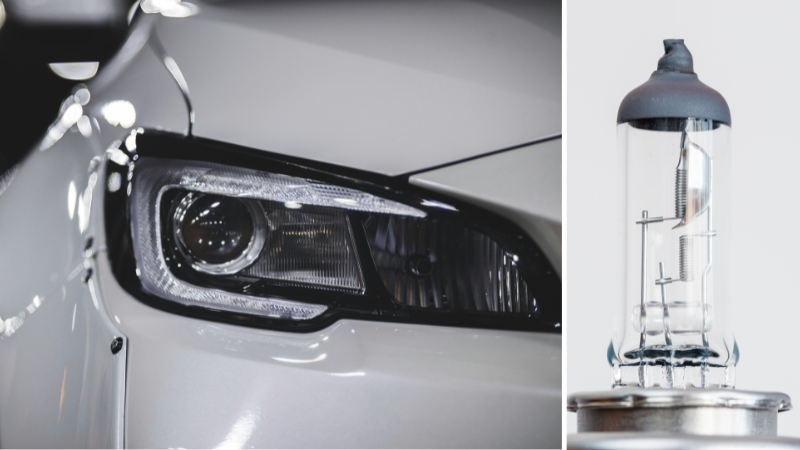
LED H7 headlights are most typically used in European cars, where precision and range are crucial. They offer both low-beam and high-beam options. They have two visible metal prongs for connection, distinguishing them from enclosed plug types such as the H11.
H7 bulbs are known for their concentrated, forward-focused beam. Hence, they are very good at providing long-distance visibility. This is critical for highway and performance driving. H7 led headlight bulbs are now widely available in traditional halogen bulbs and modern HID and LED retrofit formats.
H11 LED Light bulbs
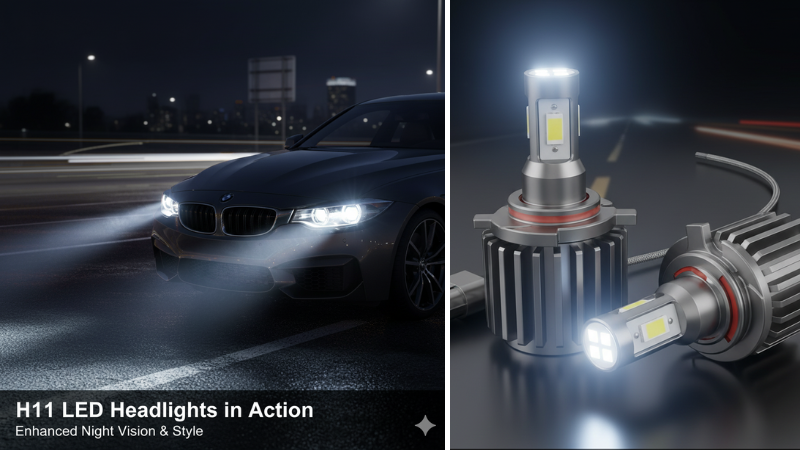
In contrast, H11 LED bulbs are more commonly utilized for fog lights and low beams in vehicles in North American and Asian markets. They have an enclosed, L-shaped plastic connector designed for secure installation. This makes them less prone to loose connections during operation.
Unlike the H7’s narrow, focused projection, H11 bulbs are designed to produce a wider, softer beam pattern. This beam pattern is better suited to low-speed driving, fog, or all-weather visibility. They, like the H7, are available in halogen, HID, and LED technologies.
The LED version has better thermal management, is energy efficient, and offers optimal performance among the choices.
Physical and Fitment Differences

Understanding the physical and fitting variations between H7 and H11 bulbs is crucial for stocking the correct products and providing informed customer support. Although both are single-filament bulbs, their connector designs, sizes, and installation processes vary a lot.
Connector and Mounting
H7 bulbs have two exposed prongs that insert into the socket. Generally, they require retainer rings or clips to ensure a secure connection. Their bigger size and twist-and-lock installation method can take longer to manage and may necessitate adapters in certain car types.
In contrast, H11 bulbs have a sealed, L-shaped plastic connector that allows for simple plug-in installation. While also providing improved protection against dust and moisture.
They are smaller in size, making them easier to handle. Moreover, they slot directly into the housing, eliminating the need for additional hardware.
Bulb Size and Installation

H7 bulbs are larger in size and have a twist-and-lock fitment method. This installation approach frequently takes longer and, in certain situations, may necessitate the use of additional adapters to ensure precise alignment.
For example, some automobiles, such as the 2015 Kia Sorento headlight bulb or the 2012 Hyundai Sonata headlight bulb, rely on exact housing designs, making accurate size vital for both halogen and LED updates.
H11 bulbs, on the other hand, are smaller and use a direct insert-and-lock mechanism. This makes installation quicker and faster, typically eliminating the need for additional hardware.
H11 bulbs’ tiny fit makes them ideal for current assemblies, such as those used in 2014 Hyundai Sonata headlight bulb configurations, where space efficiency and ease of replacement are critical.
Regional Applications

From a regional standpoint, H7 bulbs are commonly utilized in European automobiles, particularly for both low and high beam headlights. Their forward-focused beam design makes them an excellent choice for highway driving in these markets.
In contrast, H11 bulbs are widely utilized in North American and Asian vehicles for low beams and fog lights. This includes support for modifications such as the LED 9012 headlight bulb. This improves vision in fog-prone or urban driving conditions.
Understanding these market variations enables distributors and service shops to supply the appropriate items for each consumer category while lowering return rates due to fitment concerns.
Performance and Use Case Comparison

The performance variations between H7 and H11 bulbs affect both stocking decisions and customer satisfaction. Although both types of bulbs are commonly used, their beam focus, visibility, and applications differ. Hence, understanding these differences is critical for product recommendations.
Beam Focus and Brightness
H7 bulbs are designed to provide forward-facing lighting. They create a concentrated beam that enhances long-distance visibility. Thus, making them a popular choice among highway drivers. Mostly SUVs like the 2015 Kia Sorento headlight bulb seek replacement with H7 features.
In comparison, H11 bulbs have a greater beam dispersion. Their design allows for efficient near-to-midrange coverage. This is why they are widely employed in fog light applications. H11 bulbs are frequently recommended for city driving, where wide lighting is required.
Glare and Visibility
H7 bulbs can produce glare if they are incorrectly installed in reflector housings, especially when updated to LED. Proper orientation and alignment are critical for avoiding consumer complaints and safety concerns.
H11 bulbs typically produce a softer cut-off line, which reduces glare and increases driving comfort for oncoming traffic.
Versatility and Technology Options
Both the H7 and H11 models are available in halogen, HID, and LED technologies. However, LEDs are the most popular alternative in today’s market due to their longer lifespans, higher energy efficiency, and cool white light output.
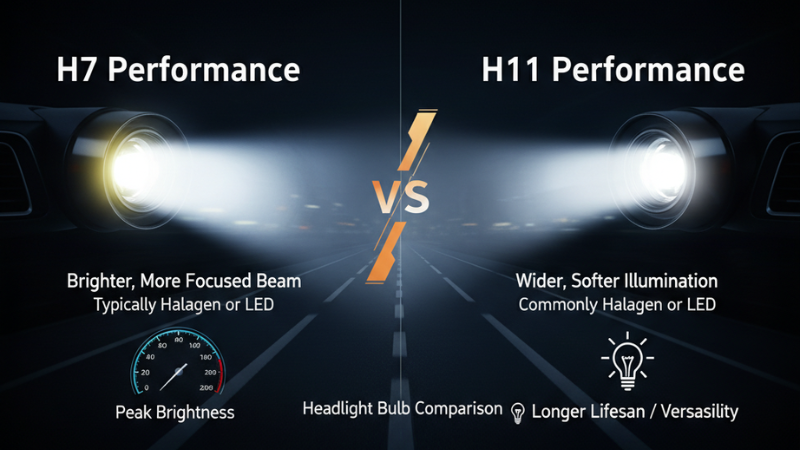
H7 vs H11 Performance Overview
| Feature | H7 Bulb | H11 Bulb |
|---|---|---|
| Beam Type | Brighter, focused, long-range | Wider spread, near-midrange |
| Common Use | High/low beams in European vehicles | Low beams & fog lights in NA/Asian |
| Glare Risk | Higher if misaligned | Lower, softer cut-off |
| Lighting Technologies | Halogen, HID, LED | Halogen, HID, LED |
| Daytime Running Light | Not present | Not present |
| Best For | Distance vision, highway driving | Foggy weather, urban/city driving |
Pros and Cons at a Glance
In the H7 vs H11 comparison, both bulbs have advantages depending on the driving situations. But each has drawbacks as well.
H7 LED bulbs
Pros:
- Stronger forward projection provides brighter, more concentrated beams for long-range vision on roads.
- Available in halogen, LED, and HID formats, providing versatility for various markets.
- Favored in European automobiles, where precise lighting is required.
Cons:
- Improper alignment can cause glare, particularly in reflector housings.
- Installation can be more complicated, needing retaining rings or adaptors.
- The design is slightly thicker than the H11, which limits compatibility in narrow housings.
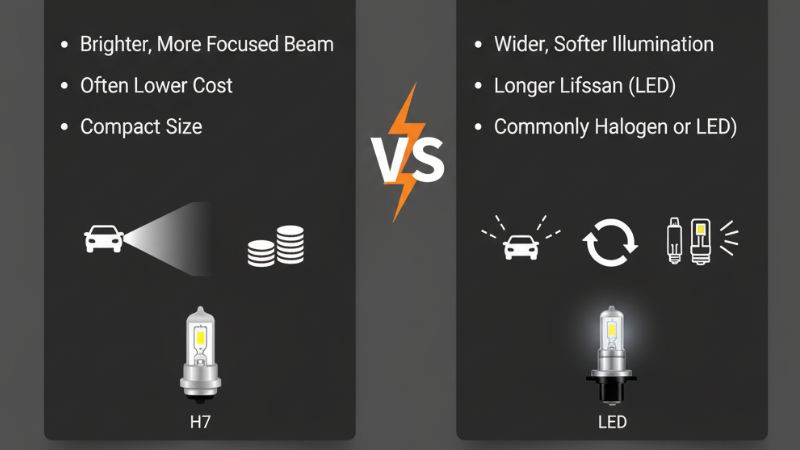
H11 LED headlight bulbs
Pros:
- H11 bulbs have a wider beam spread, making them ideal for fog lights and low-speed urban driving.
- The L-shaped plug simplifies installation and ensures a secure fit.
- Typically produces reduced glare, allowing for safer operation in a variety of traffic circumstances.
Cons:
- Lower brightness output than H7, limiting long-distance performance.
- The primary application is for fog or low beams, which limits its adaptability.
- If not chosen carefully, some aftermarket versions may result in poor beam focus.
Conclusion
H7 and H11 headlight bulbs serve different purposes: H7 gives focused, long-range illumination excellent for highway travel, whilst H11 provides a broader spread suitable for foggy or city conditions.
Selecting the correct bulb type assures compliance, safety, and performance. All of which are crucial for preserving customer satisfaction and preventing costly returns.
Partner with Carlight Vision to make smarter inventory decisions.
At CarlightVision, we help distributors, retailers, and automotive professionals match the proper supplies to specific vehicle needs. From compliance advice to bulk sourcing, our team guarantees you have reliable, high-performance solutions.
Contact our specialists today to receive specialized recommendations or a quotation for your next order.
Frequently Asked Questions
Q1. Can I use an H7 instead of an H11?
A. No, H7 and H11 bulbs are physically and electrically unique, with separate bases, connectors, and diameters. Attempting to switch them may result in a poor fit, beam misalignment, or even electrical problems. For distributors and installers, educating clients about these incompatibilities decreases returns while also ensuring safety.
Q2. Do LEDs exist for both types?
A. Yes, H7 and H11 bulbs are generally available in LED form. However, appropriate fitment and alignment are important to road safety. A misaligned LED might result in glare and compliance difficulties. Businesses should direct customers to high-quality, CAN bus-compatible products that maintain accurate beam patterns while offering efficiency, longevity, and low maintenance costs.
Q3. Which is brighter, H7 or H11?
A. An exact brightness comparison between the two bulbs is not practical. The H7s are performance-focused as they provide higher forward illumination, making them ideal for long-distance, high-speed driving circumstances such as highways. The H11 bulbs are more visibility-focused and are primarily intended for wide beam spread and fog applications.
Q4. Which bulb also acts as a fog light?
A. H11 bulbs are the safer option in foggy or low-visibility conditions. Their wider light distribution and softer cutoff lessen glare and reflection, enhancing visibility in mist, rain, or snow.
Q5. How to confirm bulb type for my vehicle?
A. The most reliable technique is to consult the owner’s manual. You can also inspect the existing bulb base or use reputable internet bulb locator tools. A supplier can also help you by choosing the best bulb type.
